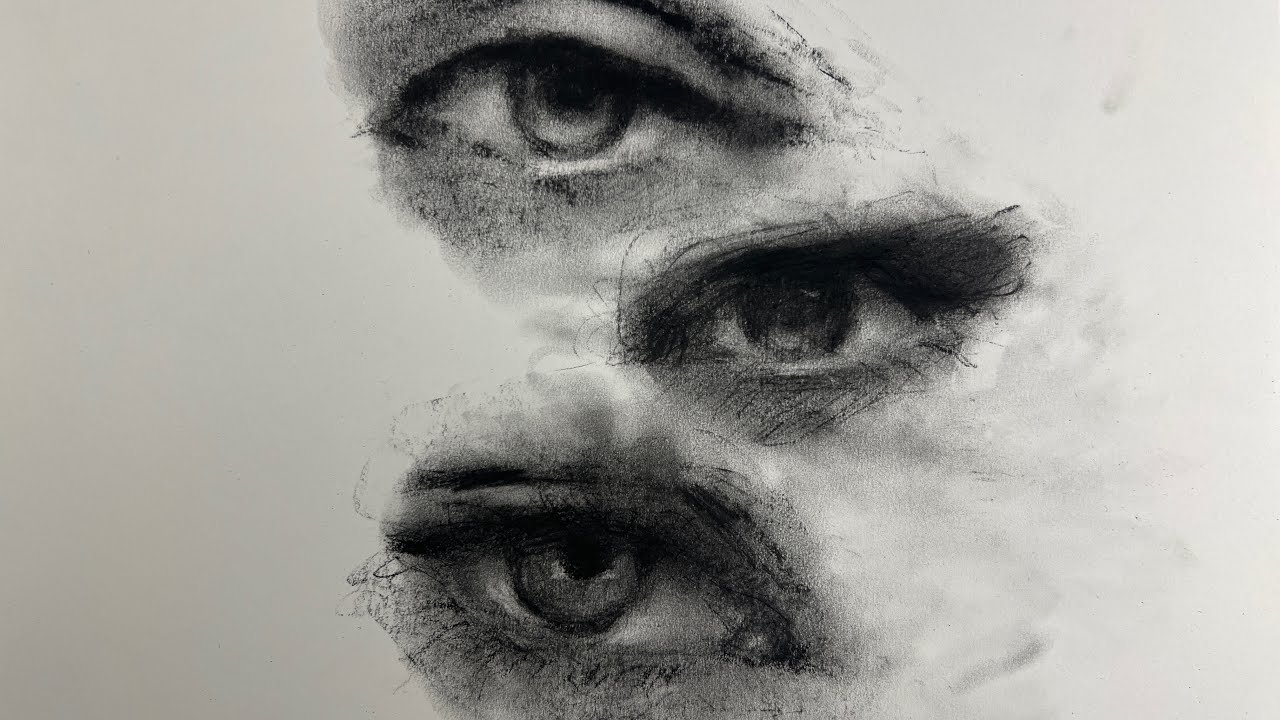Charcoal drawing boasts an unparalleled richness and depth, making it an ideal medium for capturing the most expressive features of the human face: the eyes. Often referred to as the windows to the soul, eyes harbor complexity and depth, challenging artists to encapsulate their essence. This article delves into techniques and insights for mastering the art of charcoal eye drawing, guiding artists to capture not just the appearance but the soul behind the gaze.
Essential Tools and Preparation
Selecting Your Charcoal
The journey begins with choosing the right charcoal. For detailed work like eye drawing, a combination of vine and compressed charcoal offers flexibility. Vine charcoal allows for soft, light strokes, ideal for initial outlines and shading. Compressed charcoal, being darker and denser, is perfect for adding depth and definition. A charcoal pencil can further refine details, providing precision for the intricate parts of the eye.
Preparing the Paper
A smooth to medium-textured paper works best for eye drawings, offering a balanced surface for both detail and blending. Prior to sketching, some artists prefer to lightly coat the paper with a layer of charcoal powder. This initial layer provides a mid-tone base, allowing for the effective use of both additive (adding charcoal) and subtractive (erasing) techniques to model the form of the eye.
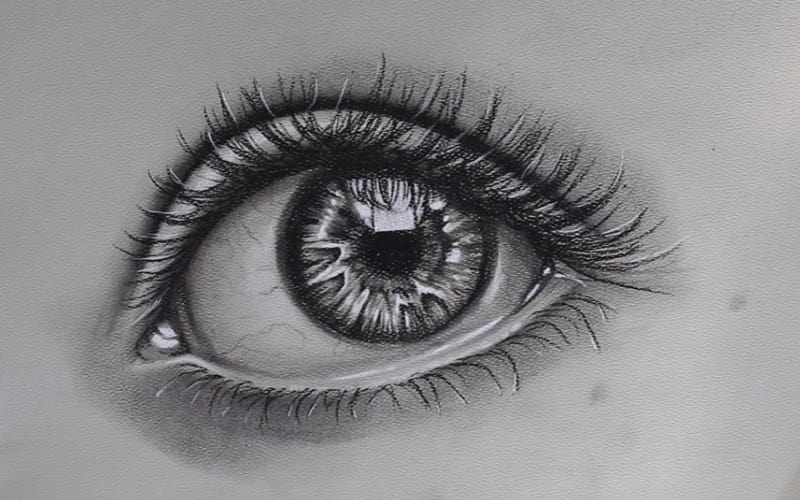
Laying the Foundation
Sketching the Basic Shape
The first step in the drawing process is to establish the eye’s basic shape. Observing your reference, sketch the outline lightly with vine charcoal, focusing on the overall form without getting caught up in details. This stage is about capturing proportions and the eye’s relation to its surroundings, ensuring a solid foundation for further refinement.
Establishing Light and Shadow
Identifying where the light hits and where the shadows fall is crucial in creating realism. Use a soft touch to map out the lightest and darkest areas, keeping in mind that the white of the eye is rarely pure white. This approach sets the stage for a dynamic range of tones, crucial for achieving depth in the drawing.
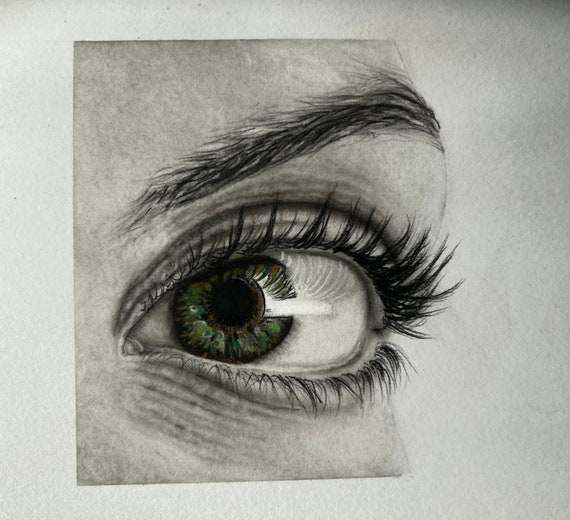
Crafting Depth and Realism
Detailing the Iris and Pupil
The iris deserves special attention, as its patterns and colors (though rendered in grayscale) contribute significantly to the eye’s expressiveness. Use a charcoal pencil to suggest the texture of the iris, and shade the pupil, considering its response to light. Remember, the pupil’s sharp contrast is often the focal point of the eye, drawing the viewer in.
Working on the Eyelids and Lashes
Eyelids and lashes add emotion and depth. When drawing the eyelids, consider their thickness and the way they wrap around the eyeball. For eyelashes, avoid uniform, straight lines; instead, vary length and direction to mimic natural growth. These details can dramatically enhance the eye’s realism and expressiveness.
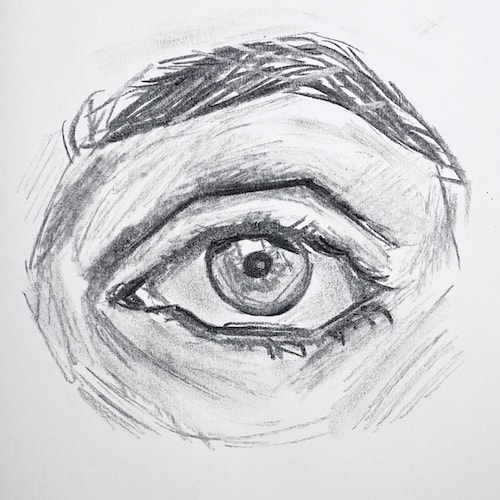
Final Touches
Refining with Highlights and Shadows
With the eye’s main components in place, it’s time to refine. Use your eraser to lift charcoal off the paper, creating highlights that bring life to the eye, especially on the cornea and tear ducts. Intensify the darkest areas, like the pupil and the shadow the upper eyelid casts, to give the drawing more depth. This contrast between light and dark is key to capturing the soulful quality of human eyes.
Blending for Realism
Smooth transitions between the different tones in the eye are essential for achieving a realistic look. Use a blending stump or your finger to softly blend areas, ensuring there are no harsh lines or unnatural transitions. This technique is particularly useful around the edges of the iris and where the eyelid meets the sclera, offering a gentle gradient that mimics the natural form.
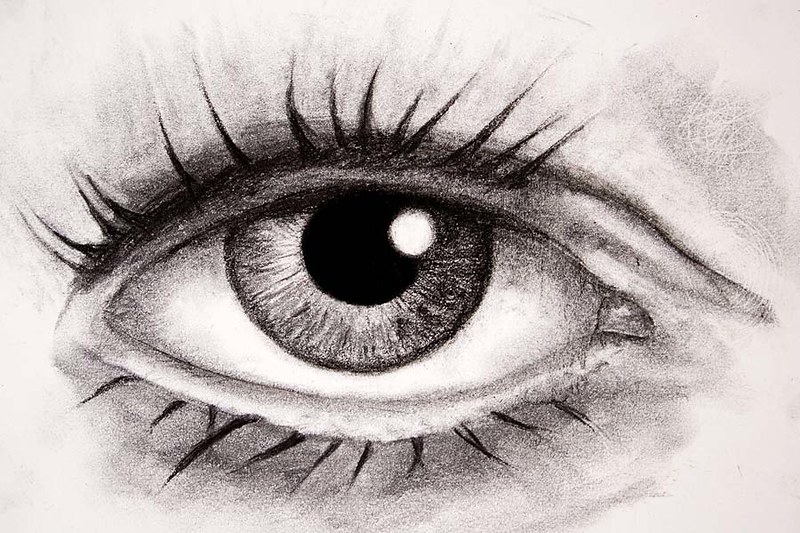
Reflecting on the Process and Practice
Continuous Learning
Charcoal eye drawing is an art that demands patience and practice. Each drawing is a learning experience, providing insights into the delicate interplay of light and shadow, line and texture. Artists should continuously experiment with different techniques and approaches, refining their ability to capture the depth and emotion of the eyes.
Seeking Critique and Inspiration
Feedback from fellow artists and mentors can offer new perspectives and insights, helping to improve skills and techniques. Additionally, studying the works of others, from Old Masters to contemporary artists, can inspire and inform your approach to drawing eyes with charcoal, enriching your artistic vocabulary.
Enhancing Expression through Details
Adding Life with Reflective Highlights
The spark of life in an eye drawing often comes from the addition of reflective highlights. These tiny marks represent the reflective nature of the eye’s surface and can be strategically placed to suggest moisture and vitality. A pointed eraser or a sharp-end tool can be used to carefully pick out small areas of the charcoal, creating these pinpoint reflections. Careful not to overdo it, as the balance of reflection accentuates realism and too much can detract from it.
Emphasizing the Eyebrow’s Influence
Though not part of the eye itself, the eyebrow plays a critical role in expressing emotion and framing the eyes. Use varied strokes with the charcoal pencil to replicate the texture of hair and to define the arch’s contour. By adjusting the eyebrow’s shape and position, artists can convey an array of emotions—furrowed brows for anger, raised for surprise, or relaxed for a neutral expression.
Accounting for the Surrounding Area
Remember that the area surrounding the eyes can greatly affect their appearance and expression. Shadows cast by the brow bone, the form of the cheekbone, and the presence of wrinkles or laugh lines contribute to the overall sense of depth and emotion. Use your charcoal to gently shape these aspects, bearing in mind that the subtlety of these details can make a significant difference in the believability and emotional resonance of the eye.
Refining through Contrast and Composition
Balancing Charcoal Tones
Mastering the art of charcoal eye drawing involves a keen sense of tonal balance. Achieving the right contrast between the various parts of the eye and its surrounding features sets the stage for a striking image. For instance, deeper shadows beneath the eyelashes against the lighter tone of the sclera can accentuate the eye’s curvature. Artists must judiciously apply and manipulate charcoal’s broad tonal range to enhance depth while preserving harmony within the drawing.
Composing the Gaze
The gaze of the eye within the composition can have a powerful impact. Consider the direction and quality of the gaze—whether direct, averted, or looking upward or downward. This gaze, in synergy with the composition, can guide viewers through the artwork, invoking curiosity and engagement. By thoughtfully arranging the eye’s pose and pairing it with complementary compositional elements, artists can imbue their charcoal creations with meaning and intention.
Beyond Technique
While technique is paramount in drawing, capturing the soul through the eyes in charcoal goes beyond mere technical skill. It’s about connecting with your subject on a profound level, understanding the emotional weight and stories behind the gaze. This connection, coupled with mastery over charcoal, allows artists to create compelling, soulful representations of the human eye, transforming simple portraits into gateways to the unseen depths of human expression. Embrace this challenge, and let each drawing be a step closer to unveiling the complex beauty found within the soul.
